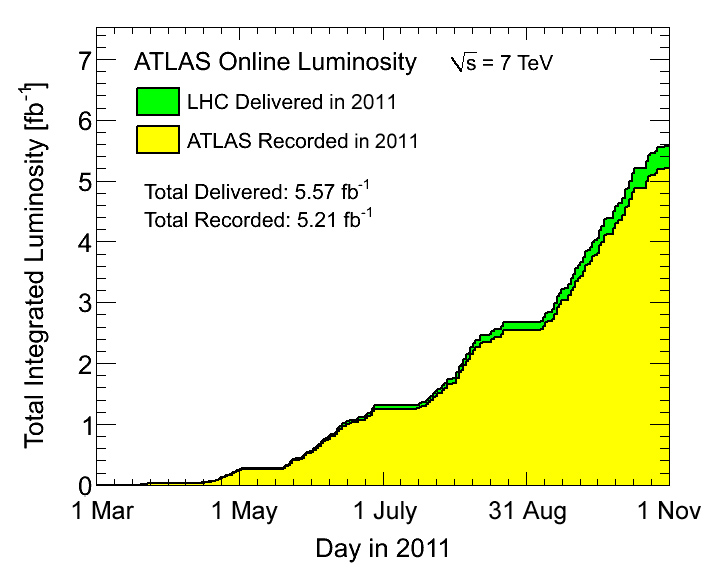ATLAS reaches milestone: 5 inverse femtobarns of data!
28 October 2011 | By

In an amazing year that has exceeded our expectations, the Large Hadron Collider has delivered, and ATLAS has recorded, over 5 inverse femtobarns (fb-1) of collisions. These units correspond to having 3.4 x 1014 or 340 000 000 000 000 total collisions. Most analyses presented at the last major conference (the Lepton Photon Symposium in August in Mumbai) made use of about 1 fb-1, so this is a big jump.
The ATLAS detector has worked remarkably well, not only recording data during 94% of the LHC live-time, but doing so with great precision. The 2011 proton run ends in October, when the LHC switches to collisions of heavy ions.
While this is an enormous amount of data, it should be seen in context. It is actually about 1% of the data we expect over the next few years, and in addition, the energy of these collisions will be doubled in 2014, which will greatly extend the range of our searches for new discoveries.
During the next few months, which include a three-month LHC shutdown for maintenance and upgrades, the members of the ATLAS collaboration will be feverishly analyzing the data that have been accumulated this year.
Our goal is to present the results of analyses that include the full 2011 dataset during conferences in February and March 2012. There are many subtleties in analyzing LHC data, and conditions in the detector change somewhat over time, so many details must be considered to assure the highest quality of the results that ATLAS reports.
Much attention in the news media and elsewhere has focused on the search for the Higgs boson. The Higgs boson is a prediction of the Standard Model as a means to understand the origin of mass of fundamental particles.
The prospects for the future (winter 2012 conferences) include the possibility of finding the first hints for a Higgs boson in the region of masses between 114 and 145 GeV. If there is no Higgs boson in that mass region, ATLAS may be able to exclude it at the 95% confidence level. Neither the hint nor the exclusion at 95% level would be definitive at that time, and more conclusive results may be available one year later.
If the Higgs were to have a higher mass, then the signals for its decays would be much easier to find. ATLAS has already excluded masses at the 95% confidence level for most masses in the range 145 to 460 GeV. However, the expectations of the Standard Model are that the Higgs boson has a mass in the lower range.
ATLAS collaborators are similarly searching for evidence of other exciting possible discoveries. One of these is supersymmetry, which predicts many new particles to be found at high masses, including the prime candidate for the dark matter particle. Dark matter pervades our universe, but has not yet been identified.
Other searches are looking for evidence that quarks may not be fundamental but consist of more basic particles, or for evidence of new fundamental forces of nature evidenced by new particles called W' and Z'. Another exciting possibility would be to find evidence for extra dimensions of space.
We hope to find signs of new discoveries in the data at hand, but nature might make us wait another year or even several years. We do experiments because we do not know the answers in advance.



